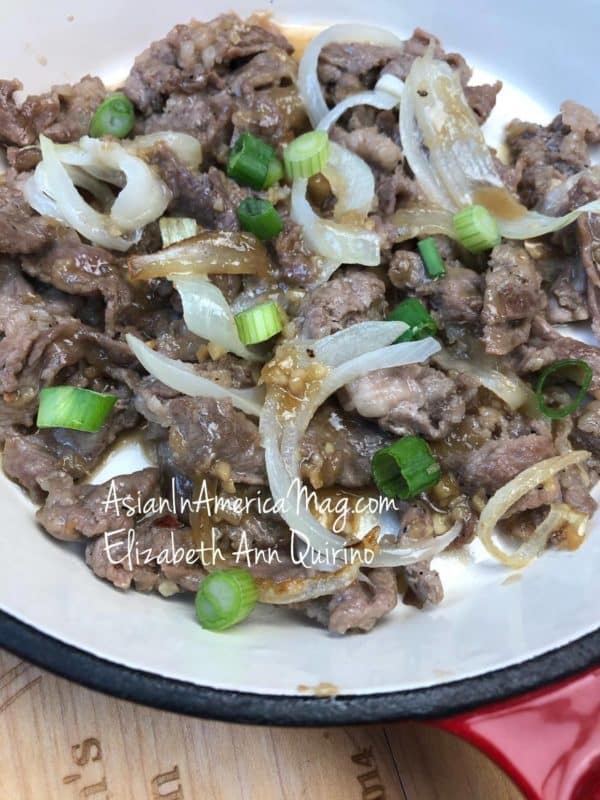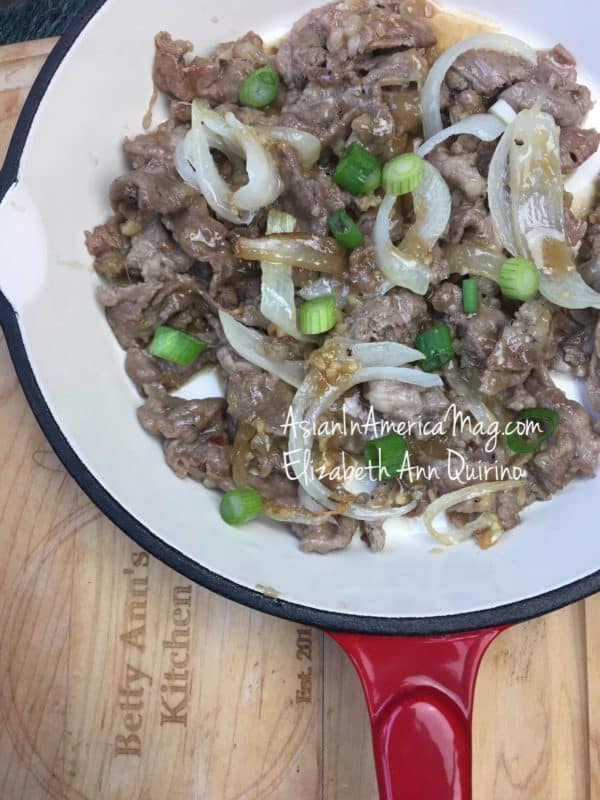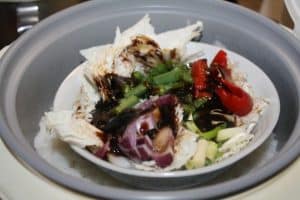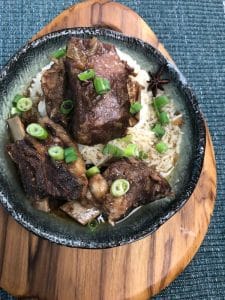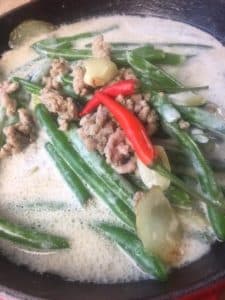Lomo-Lomo
As an Amazon Associate and member of other affiliate programs, I earn from qualifying purchases.
Another great Filipino dish I cooked while on quarantine was Lomo-Lomo. I have been cooking comfort food every day. The uncertainty of the pandemic crisis has left us with frayed nerves. So, I constantly search cookbooks for things to cook, or a dish that requires basic ingredients.
During a recent interview with my friend, Chef Malou Perez-Nievera, for an article I was writing on her cookbook, she recommended this: “ Try my Lomo Lomo, “ Malou said. “It’s easy, rustic, and homey.”
Lomo is defined as the Spanish word for tenderloin, in other books about Ilocano cuisine (from the northern Luzon provinces in the Philippines). In different Lomo-Lomo versions, Ilocanos cook this with pig’s innards like the heart, liver and sometimes, the brain.
Since we’re on lockdown and limit our grocery trips, I only had a slab of pork shoulder in my freezer. I knew this would be enough for a dish that exudes sheer comfort with one look at the easy procedure.
After boiling the pork and rendering the fat, I sautéed the pork strips. The fresh ginger aroma floated from the simmering skillet. That and the strong salty flavor of the Bagoong Monamon (salted anchovies) defined this dish. After pouring the seared pork slices with its thick gravy, on steamed rice, I knew what Malou meant when she said, “It is not just a recipe for you to eat, it feeds the soul.”
This was just what we needed today. Though the days seem unsettling, often I am comforted by soothing messages from friends to keep the faith, stay strong and stay home to save lives. This recipe from Malou’s cookbook was like a calming message from a friend that everything will be alright.
Read my complete article and review of the Connecting the Pots Cookbook by Malou Perez-Nievara, which published on Positively Filipino online magazine. Click here.
You can purchase Malou’s cookbook from her blog SkipToMalou.net or on Amazon.
Lomo-Lomo
Equipment
- Large skillet or Wok: 12 to 14 inches diameter
Ingredients
- 2 pounds pork shoulder or pork loin sliced into 1/2-inch strips; trim fat
- 2 Tablespoons vegetable oil
- 4 cloves garlic peeled; minced
- 1 whole medium-sized onion sliced
- 2 knobs (a thumb size each) fresh ginger peeled; sliced and then pressed using a pestle or back of a large knife
- 1/2 cup white vinegar
- 2 Tablespoons bagoong Monamon (salted anchovies) also called bagoong dilis or bagoong balayan
- 1 teaspoon ground black pepper powder
- 1 stalk scallions chopped, for garnish
For serving:
- steamed rice
Instructions
To prepare the pork:
- Trim the fat off the pork. Reserve the fat slice for the saute.Slice the pork into paper-thin slices, 1/2-inch sized each.Set aside.
To saute the Pork Lomo-Lomo:
- Using a large skillet or wok, over medium-high heat, place in the center, the piece of fat which was earlier trimmed off. Pour 1/2 cup of water.Add the pork slices. Let the water boil, then lower to medium heat. Allow the water to evaporate till the liquid is reduced. When liquid is gone in about 6 to 8 minutes, the fat renders its own oil - about a tablespoon.Remove the pork slices and the pieces of fat.
- Pour vegetable oil into the skillet to add to the fat rendered. When oil is hot enough in 1 to 2 minutes, saute the garlic, onions and pressed fresh ginger.Return the meat slices to the skillet with the saute (discard the chunk of fat earlier trimmed). Continue cooking for 12 to 15 minutes more till the pork is nicely browned all over.
- Pour the vinegar into the skillet over the pork. When the liquid is boiling, add the bagoong Monamon (salted anchovies). Season with black pepper and mix ingredients. Cover the skillet. Continue cooking for 5 minutes more for flavors to blend.Plate on a serving platter and garnish with chopped scallions. Serve warm with rice.
Cook's comments:
- The ingredient Bagoong Monamon (known in the Ilocano provinces) used in this recipe is also known as Bagoong Dilis, It is bottled fermented salted anchovies, used as a condiment or as a side dipping sauce to different Philippine dishes. The bottled Bagoong Monamon can be found in Asian markets or online sources here in the USA. In the Philippines, it is widely available in groceries or on trips to the northern provinces of Luzon, are sold by roadside vendors in fruit and vegetable stands. This was always a "pasalubong" (gift from travel) which we purchased on road trips to the north.
Notes on Nutrition: The nutrition information provided is an estimate and will vary based on cooking methods and specific brands of ingredients used.
Did you like this recipe?I have more Filipino Instant Pot recipes in my newest cookbook Instant Filipino Recipes: My Mother’s Traditional Philippine Cooking in A Multicooker Pot by Elizabeth Ann Besa-Quirino. I also have more classic recipes inspired by my mother’s cooking in my popular cookbook: My Mother’s Philippine Recipes. If you’re learning how to cook Filipino food or a fan of Philippine cuisine, buy my cookbooks and books on Amazon.com sold worldwide in paperback and Kindle format.
Copyright Notice: Hello, Friends! Please DO NOT LIFT OR PLAGIARIZE my original recipe, stories, photos or videos. All the images and content on this blog are COPYRIGHT PROTECTED and owned by my media company Besa-Quirino LLC. This means BY LAW you are NOT allowed to copy, scrape, lift, frame, plagiarize or use my photos, essays, stories and recipe content on your websites, books, films, television shows, videos, without my permission. If you wish to republish this recipe or content on media outlets mentioned above, please ASK MY PERMISSION, or re-write it in your own words and link back to my blog AsianInAmericaMag.com to give proper attribution. It is the legal thing to do. Thank you. Email me at [email protected]

